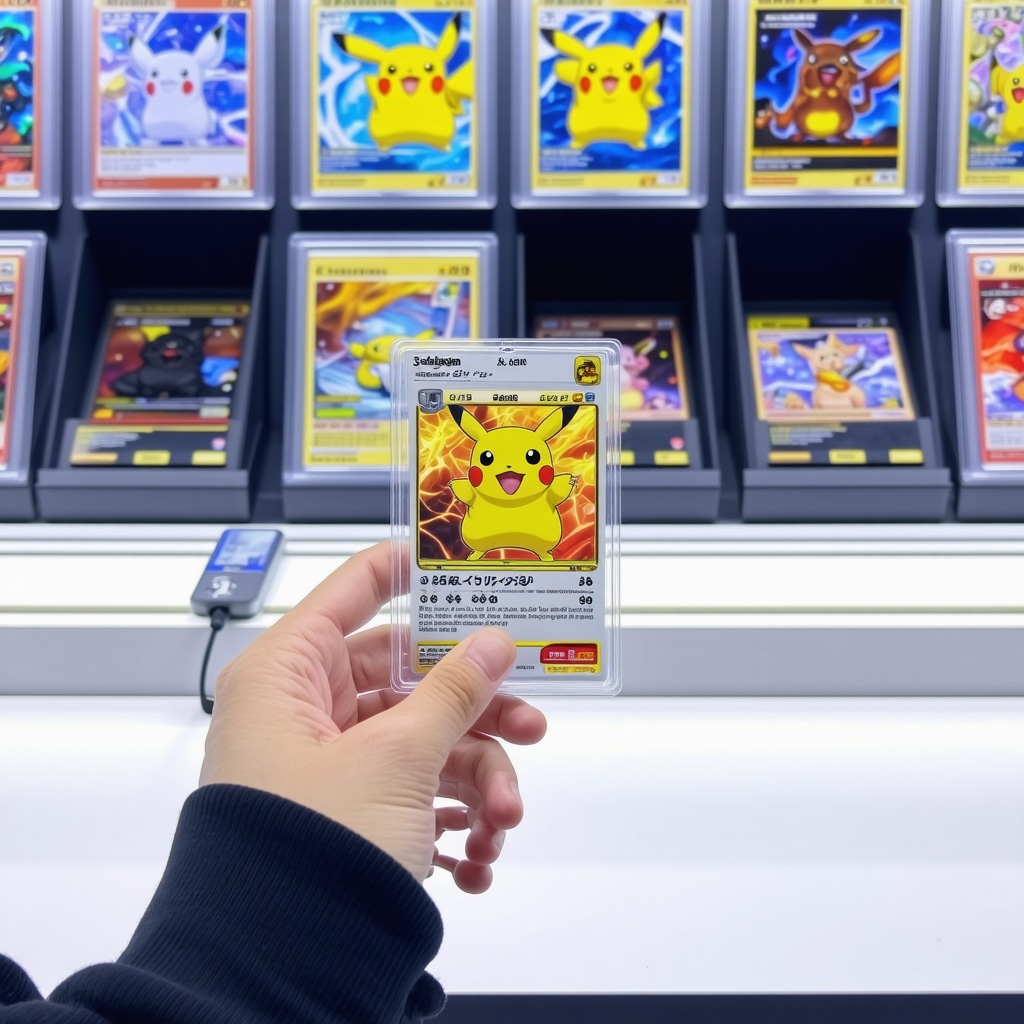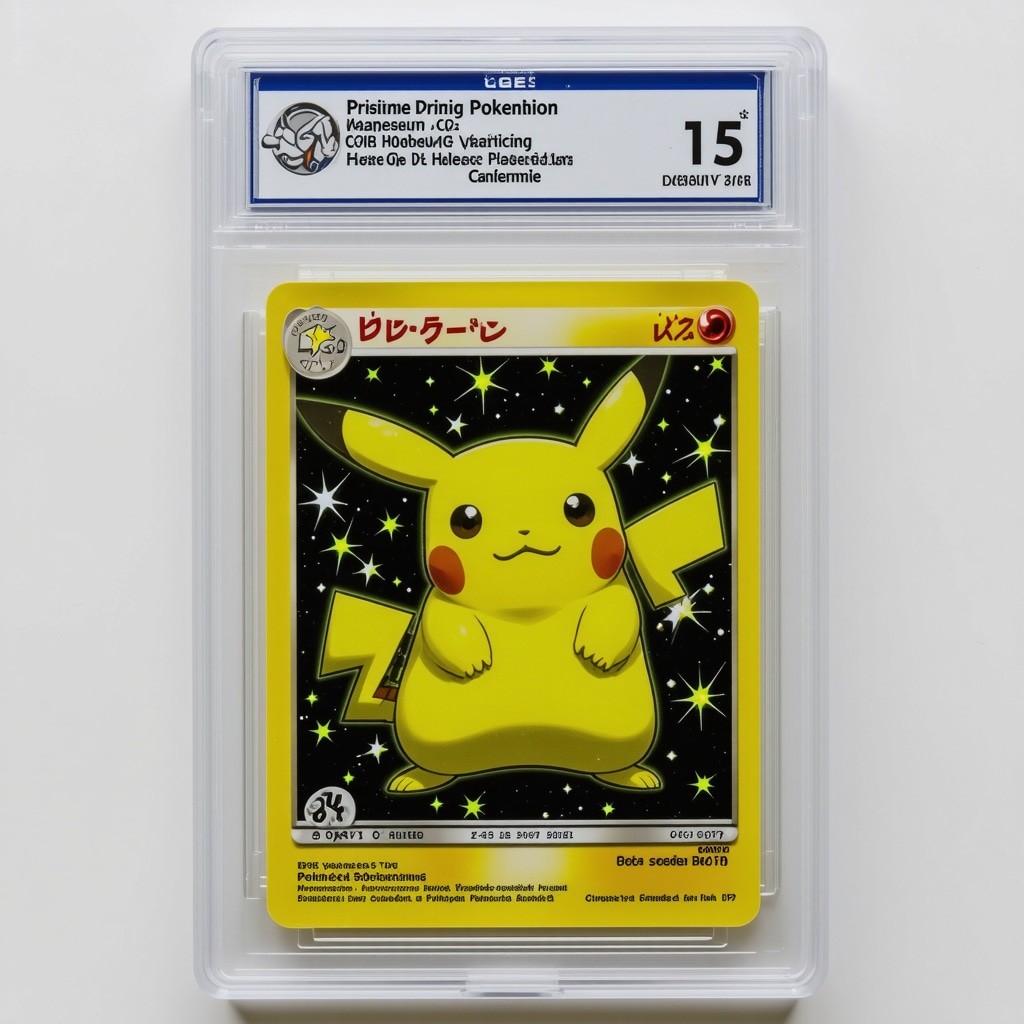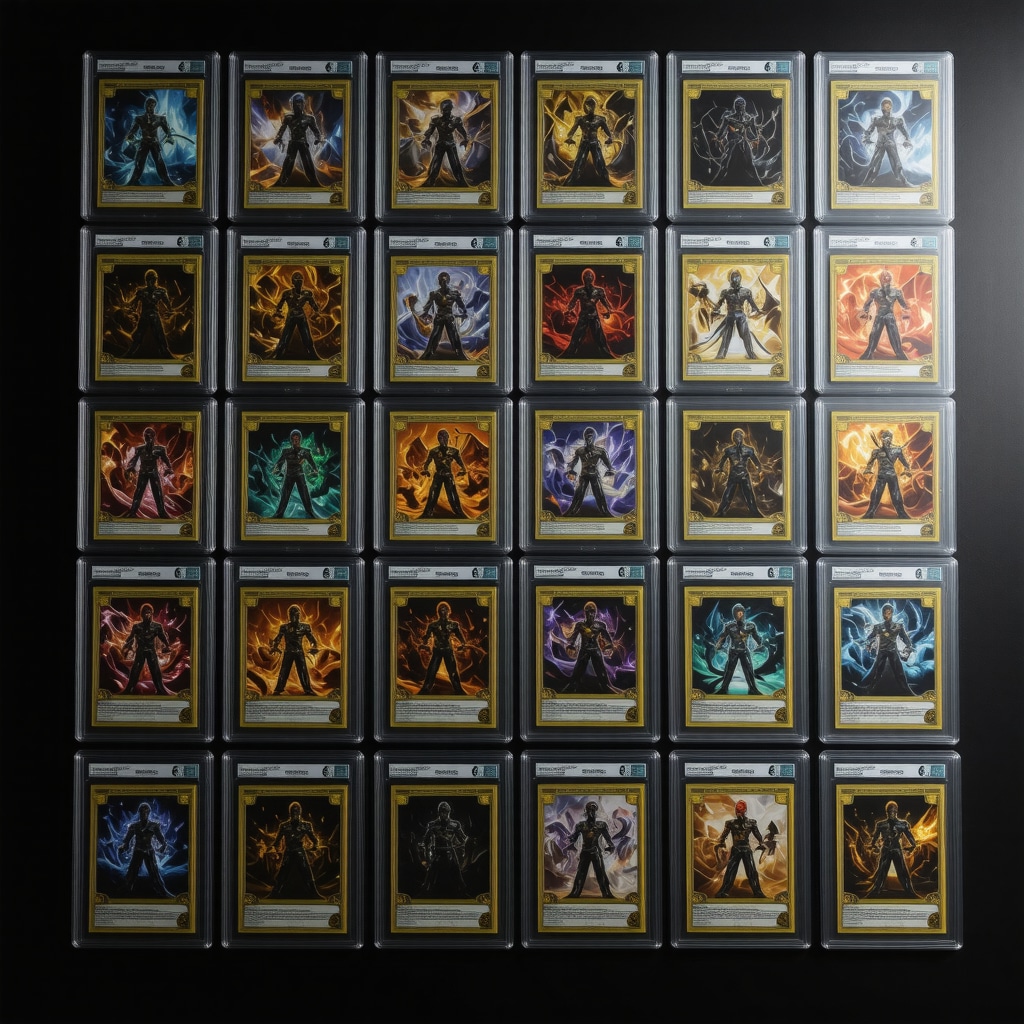Discovering the Pinnacle of CGC Graded Japanese Rare Cards in 2025
In the dynamic world of collectible card gaming, Japanese Pokémon cards graded by CGC have carved a niche for serious collectors and investors alike. The year 2025 introduces an exciting era where rarity, condition, and provenance converge, making CGC graded Japanese rare cards a coveted treasure. From pristine base set Charizards to elusive promo special editions, understanding what sets these cards apart is paramount for collectors aspiring to elevate their collections or capitalize on burgeoning market values.
Why CGC Grading Transforms Japanese Rare Cards into Collector’s Masterpieces
CGC (Certified Guaranty Company) grading offers an unbiased, professional evaluation of a card’s condition, authenticity, and overall quality, which dramatically influences market desirability. Unlike other grading services, CGC’s meticulous standards for Japanese cards—factoring centering, surface quality, edges, and corners—ensure collectors acquire cards that truly represent the pinnacle of preservation. This exactitude not only assures authenticity but also enhances liquidity by instilling buyer confidence across global markets.
What Makes Certain CGC Graded Japanese Cards Stand Out Among Collectors?
Several factors contribute to a card’s standout status. For example, CGC Pristine 10 and Gem Mint 10 grades on iconic cards such as the Japanese Base Set Charizard or Vintage Holo rares signify near-flawless condition, a rarity that exponentially increases their value. Additionally, limited print runs, special artwork, and promotional cards, like Japanese Trainer Secret Rares, command immense collector interest due to their scarcity and cultural significance within the Pokémon franchise. Cards authenticated and graded at these levels become not just collectibles but artifacts of gaming history.
Strategically Navigating the Rarity Spectrum: From Promo Specials to Vintage Holos
In 2025, collectors benefit from a deeper understanding of rarity tiers within CGC graded Japanese cards. Promo special edition cards, often released in limited quantities for events or anniversaries, are rapidly gaining traction. Their scarcity combined with pristine grades can yield impressive appreciation. Conversely, vintage holo rares from the early 1990s, especially those graded CGC 10, remain foundational investments due to their enduring popularity and nostalgic value. Mastering these nuances empowers collectors to curate a portfolio that balances immediate aesthetic appeal with long-term investment potential.
Insider Tips for Maximizing Value on Your CGC Graded Japanese Collection
Expert collectors emphasize the importance of provenance and market timing. Maintaining original packaging and certification while avoiding exposure to environmental risks preserves the card’s grade and value. Moreover, staying informed on market trends, such as emerging interest in specific sets or Pokémon characters, can guide strategic acquisitions or sales. Engaging with reputable sources like Pristine Pokémon Cards’ detailed analyses offers invaluable insights into current valuations and grading nuances.
Unlocking the Secrets: Where Can Collectors Find These Rare CGC Graded Japanese Cards?
Authentic CGC graded cards are increasingly available through specialized marketplaces, auction houses, and trusted online retailers. Platforms like eBay have listings, but discerning collectors prioritize verified sellers and detailed grading reports to avoid counterfeits. Accessing curated lists such as the Top CGC Graded Japanese Rare Cards for Serious Collectors provides a focused path to acquiring the most sought-after specimens. Networking within collector communities also unveils opportunities for private sales and trades that might not be publicly listed.
Engage with the Community: Share Your Experience or Discover More
Are you a collector or investor who has navigated the fascinating realm of CGC graded Japanese cards? Share your insights or questions in the comments below to enrich this growing community. For those eager to deepen their expertise, exploring comprehensive guides such as the Decoding CGC Grading Standards for Japanese Pokémon Cards can elevate your collecting strategy.
For further authoritative insights on collectible card grading and market trends, consider the research and reports published by PSA Card, a globally recognized grading authority that complements CGC’s expertise in the collectible card industry.
Learning From Experience: My Journey with CGC Graded Japanese Cards
When I first started collecting CGC graded Japanese Pokémon cards, I quickly realized that beyond just owning rare cards, understanding the grading nuances can make a world of difference. For instance, I once acquired a CGC Gem Mint 10 Japanese Base Set Charizard and noticed subtle differences compared to another card labeled CGC Pristine 10. This firsthand encounter pushed me to dive deeper into grading standards, which ultimately helped me make smarter investments and appreciate the artistry behind these collectibles.
How Do Subtle Grading Differences Impact Card Value?
It’s fascinating how a slight imperfection, like a barely visible edge wear or a tiny centering discrepancy, can shift a card’s grade from Pristine 10 to Gem Mint 10. These subtle differences, although minute to the naked eye, have significant repercussions in market value. For example, a CGC Pristine 10 Japanese Vintage Holo can command prices that are substantially higher than its Gem Mint 10 counterpart, reflecting collectors’ preference for absolute perfection.
This is why I always recommend studying the Decoding CGC Grading Standards for Japanese Pokémon Cards guide. It helped me refine my eye for detail and avoid common pitfalls when acquiring or selling cards.
Ever Wondered How Market Trends Affect CGC Graded Japanese Cards?
Market dynamics can be as unpredictable as the Pokémon battles themselves. Recently, I noticed a surge in demand for CGC 10 Japanese Trainer Secret Rare cards, partly because of their limited print runs and unique artwork. On the other hand, some vintage holos saw more stable, gradual appreciation. This variability highlights the importance of staying informed about collector preferences and upcoming set releases.
According to a recent report by PSA Card, grading services like PSA and CGC are witnessing increased submissions for Japanese cards, signaling a growing market interest globally. This trend reinforces the need for collectors to be proactive and strategic in their acquisitions.
Practical Tips for Protecting and Showcasing Your CGC Collection
From my experience, the way you handle and display your CGC graded cards can affect both their condition and perceived value. Always keep them in a climate-controlled environment, away from direct sunlight and humidity to prevent discoloration or warping. Using protective cases and secure display frames not only safeguards your investment but also allows you to showcase your treasures elegantly.
If you’re considering branching out or want to learn more about protecting your collection, you might find the How to Achieve CGC 10 on Your Japanese Pokémon Cards guide particularly insightful.
Connecting with Fellow Collectors: Your Stories Matter
Collecting CGC graded Japanese Pokémon cards is as much about community as it is about the cards themselves. I’d love to hear about your experiences, whether it’s a memorable find, a tough lesson, or a favorite card that holds sentimental value. Sharing these stories enriches our collective knowledge and connects us through a shared passion.
Feel free to comment below or explore more on how to connect with other enthusiasts. Your unique perspective might just be the inspiration someone else needs!
Decoding Market Volatility: Forecasting Trends in CGC Graded Japanese Cards
Navigating the volatile market of CGC graded Japanese rare cards requires not only passion but a deep understanding of economic indicators and collector psychology. Unlike traditional assets, these cards exhibit unique pricing behaviors influenced by pop culture phenomena, generational shifts, and even digital media trends. Investors who analyze auction data, social media buzz, and release schedules can anticipate spikes in demand, especially for cards linked to anniversaries or media revivals.
For instance, the resurgence of classic Pokémon series or new game releases often precipitates a surge in interest for vintage CGC graded cards, driving prices upward. Seasoned collectors recommend leveraging advanced tools such as price trend analytics platforms and auction house reports to time acquisitions and sales optimally.
How Do Grading Nuances Influence Long-Term Investment Potential of Japanese CGC Cards?
The subtleties within CGC’s grading scale extend beyond mere condition assessment; they encapsulate rarity, historical authenticity, and even printing anomalies. Cards rated Pristine 10 are often scarce due to the stringent criteria CGC employs, making them prime candidates for long-term appreciation. Conversely, a card graded Gem Mint 10, while still highly valuable, may not command the same premium.
Moreover, understanding the impact of printing variations—such as shadowless edges or holofoil patterns unique to Japanese editions—can distinguish a common card from a hidden gem. These nuances require collectors to cultivate expertise or consult grading specialists to uncover undervalued assets with exceptional growth potential.
According to a detailed market analysis by PSA Card, cards with meticulous grading combined with provenance documentation consistently outperform less rigorously authenticated counterparts over a decade span.
Preservation Mastery: Advanced Techniques for Maintaining CGC Graded Card Integrity
Beyond initial grading, the ongoing preservation of CGC graded Japanese rare cards demands rigorous environmental controls and handling protocols. Humidity fluctuations, ultraviolet light exposure, and even static electricity can imperil card quality, subtly degrading edges or causing discoloration over time.
Experts often recommend climate-controlled safes or display cases with UV-filtering glass to mitigate these risks. Additionally, using nitrile gloves during handling prevents natural oils from compromising card surfaces. Storage solutions incorporating inert materials and anti-static properties further safeguard the card’s encapsulation, ensuring that the CGC grade remains intact for future transactions.
Community Insights: Leveraging Collective Expertise for Market Advantage
Active participation in specialist forums and collector groups can exponentially increase your market acumen. These communities often share early insights into upcoming card releases, grading updates, and market shifts, providing members with a strategic edge.
Engaging with experienced collectors and professional graders also facilitates access to private sales and rare finds not publicly listed. This insider knowledge can be pivotal when seeking ultra-rare CGC graded Japanese cards that command premium valuations.
To deepen your engagement, consider joining platforms like the PSA Forums, where expert discourse and market analysis flourish, enriching your investment strategy.
Ready to elevate your collection and investment approach? Dive deeper into advanced CGC grading intricacies and market intelligence by exploring our comprehensive resources and connecting with seasoned collectors worldwide.

Deciphering the Impact of Printing Variations on Card Valuation
In the nuanced realm of CGC graded Japanese cards, subtle printing variations such as shadowless borders, unique holofoil patterns, or misprints can drastically influence a card’s desirability and market price. These anomalies, often overlooked by casual collectors, are prized by connoisseurs who understand their rarity and historical significance. For instance, a shadowless edition of a Japanese Base Set Charizard graded Pristine 10 not only commands a premium but also serves as a tangible artifact of Pokémon’s evolving print technology.
How Can Advanced Collectors Identify and Authenticate Rare Printing Variations in CGC Graded Cards?
Expert collectors employ a combination of microscopic examination, reference to official print run documentation, and comparison with known exemplars to discern authentic printing anomalies. Consultation with grading specialists who have access to proprietary databases further enhances accuracy. Additionally, leveraging ultraviolet light and reflectance tests can reveal hidden features or inconsistencies invisible to the naked eye. Mastery of these techniques ensures that collectors avoid counterfeit variants and maximize investment potential.
For authoritative technical details on printing variations and authentication procedures, PSA Card’s comprehensive market analysis remains an indispensable resource.
Implementing Proactive Environmental Controls: The Science Behind Preservation
Maintaining CGC graded Japanese cards in impeccable condition requires more than basic storage. Advanced preservation incorporates understanding of material science and environmental engineering principles. Optimal relative humidity levels between 35% and 45% minimize paper fiber degradation and prevent warping. Temperature stability averts condensation risks, while UV-filtered lighting curtails fading of inks and holofoil lusters. Employing inert, acid-free materials for storage prevents chemical interactions that could compromise card integrity over time.
Moreover, air quality management, including particulate filtration and avoidance of volatile organic compounds (VOCs), further protects encapsulated cards from subtle degradation. Collectors investing in climate-controlled safes or museum-grade display cases reap benefits by significantly extending their cards’ lifespan and preserving CGC grades.
Leveraging Data Analytics and Auction Insights for Strategic Portfolio Management
In today’s digitized market, sophisticated collectors harness data analytics platforms to monitor price fluctuations, identify emerging trends, and model future valuations of CGC graded Japanese cards. Real-time auction data combined with sentiment analysis from social media channels enables prediction of demand spikes, particularly around franchise anniversaries or media releases.
Utilizing these tools allows collectors to optimize acquisition timing and disposition strategies, balancing liquidity with appreciation potential. Additionally, understanding auction house dynamics—such as reserve pricing, bidder behavior, and provenance disclosures—empowers collectors to negotiate purchases or sales with enhanced confidence and efficacy.
Engage with a Network of Experts to Elevate Your Collection
Delving into the intricate world of CGC graded Japanese rare cards necessitates continuous learning and networking. We invite you to connect with seasoned professionals and fellow enthusiasts through specialized forums and live events. Sharing experiential knowledge and gaining insider insights will sharpen your acumen and unlock access to exclusive opportunities.
Explore our curated resources and join the conversation to transform your collecting journey into a sophisticated investment endeavor.
Ready to master the complexities of CGC graded Japanese cards? Contact our experts today and elevate your collection with unparalleled expertise.

Frequently Asked Questions (FAQ)
What distinguishes CGC grading from other grading services for Japanese Pokémon cards?
CGC employs a highly precise grading methodology tailored to Japanese cards, emphasizing factors like centering, surface quality, edges, and corners with rigorous standards. Their objective approach reduces grading variability, providing collectors with trustworthy, consistent assessments that enhance confidence in card condition and authenticity.
How important is obtaining a CGC Pristine 10 grade compared to Gem Mint 10?
A CGC Pristine 10 grade represents near-perfect condition with virtually no visible flaws, making these cards exceptionally rare and valuable. While Gem Mint 10 cards are also of outstanding quality, the subtle defects that differentiate them from Pristine 10 can significantly impact market value, particularly for iconic Japanese rare cards.
Can printing variations affect the value of CGC graded Japanese cards?
Absolutely. Variations such as shadowless borders, holofoil pattern differences, or misprints can create rarity within rarity. When authenticated and graded, these anomalies often command premiums due to their uniqueness and historical significance in the card’s production lineage.
What are the best practices for preserving CGC graded Japanese cards post-grading?
Maintain stable temperature and humidity (ideally 35-45% RH), avoid direct sunlight, use UV-filtered display cases, handle with nitrile gloves, and store in inert, acid-free materials. These controls prevent degradation, discoloration, and physical damage, preserving the CGC grade and card value over time.
Where can collectors find authentic CGC graded Japanese rare cards safely?
Trusted sources include specialized marketplaces with verified sellers, reputable auction houses, and curated collections on platforms dedicated to high-grade Japanese cards. Engaging with collector communities and utilizing detailed grading reports ensures authenticity and reduces counterfeit risks.
How do market trends influence the investment potential of CGC graded Japanese cards?
Market dynamics are driven by factors such as franchise anniversaries, new game releases, and pop culture revivals. Data analytics and auction insights enable collectors to anticipate demand spikes and strategically time acquisitions or sales, maximizing appreciation and liquidity.
Why is provenance important when collecting CGC graded Japanese cards?
Provenance documents a card’s history and ownership chain, adding credibility and assuring buyers of authenticity. Cards with well-documented provenance generally achieve higher valuations and attract serious collectors seeking investment-grade assets.
How can newcomers familiarize themselves with CGC grading nuances?
Begin by studying detailed grading guides, such as those decoding CGC standards for Japanese Pokémon cards, and participate in collector forums. Observing graded card examples and consulting experts enhances understanding of subtle condition distinctions and market implications.
Is it worthwhile to engage with collector communities for trading or learning?
Yes. Communities offer invaluable insider knowledge, early access to rare cards, and shared experiences that deepen expertise. Networking can uncover private sale opportunities and foster collaborative learning vital for advanced collecting and investment decisions.
What role do advanced data tools play in managing a CGC graded Japanese card portfolio?
Data analytics platforms track pricing trends, auction results, and social sentiment, enabling collectors to forecast market movements and optimize portfolio timing. These insights support informed decision-making, balancing potential gains with risk management.
Trusted External Sources
- PSA Card (Professional Sports Authenticator): Renowned for comprehensive grading standards and market analysis, PSA provides authoritative research on collectible card market trends, grading nuances, and investment insights relevant to Japanese Pokémon cards.
- Pristine Pokémon Cards: Specialized in Japanese Pokémon card grading and investment, this platform offers in-depth guides, valuation reports, and curated listings essential for understanding CGC grading impacts and market dynamics.
- PSA Forums: A vibrant community hub where collectors, graders, and investors exchange expert knowledge, early market intelligence, and authentication techniques for Japanese rare cards.
- Academic and Industry Publications on Material Preservation: Research from conservation science journals and museum studies informs best practices for environmental controls and long-term preservation of collectible paper artifacts.
- Leading Auction Houses (e.g., Heritage Auctions, PWCC): These entities publish detailed sales records and trend reports that help collectors gauge real-world demand and pricing fluctuations for CGC graded Japanese rare cards.
Conclusion: Mastering the Art and Science of CGC Graded Japanese Rare Cards
In 2025, CGC graded Japanese rare cards stand at the crossroads of cultural heritage and savvy investment. Their value transcends mere aesthetics, embodying historical significance, meticulous preservation, and market dynamics shaped by rarity and grading precision. Collectors who grasp subtle grading distinctions, embrace advanced preservation techniques, and leverage data-driven market analysis position themselves to both enjoy and profit from these collectibles.
As the market evolves, engaging with trusted sources and community expertise remains indispensable. Whether you are embarking on your collecting journey or refining a seasoned portfolio, understanding the nuances of CGC grading and Japanese card rarity empowers you to make informed, confident decisions.
Ready to elevate your collection to new heights? Share your experiences, ask questions, and explore our expert resources to deepen your mastery of CGC graded Japanese rare cards today.
